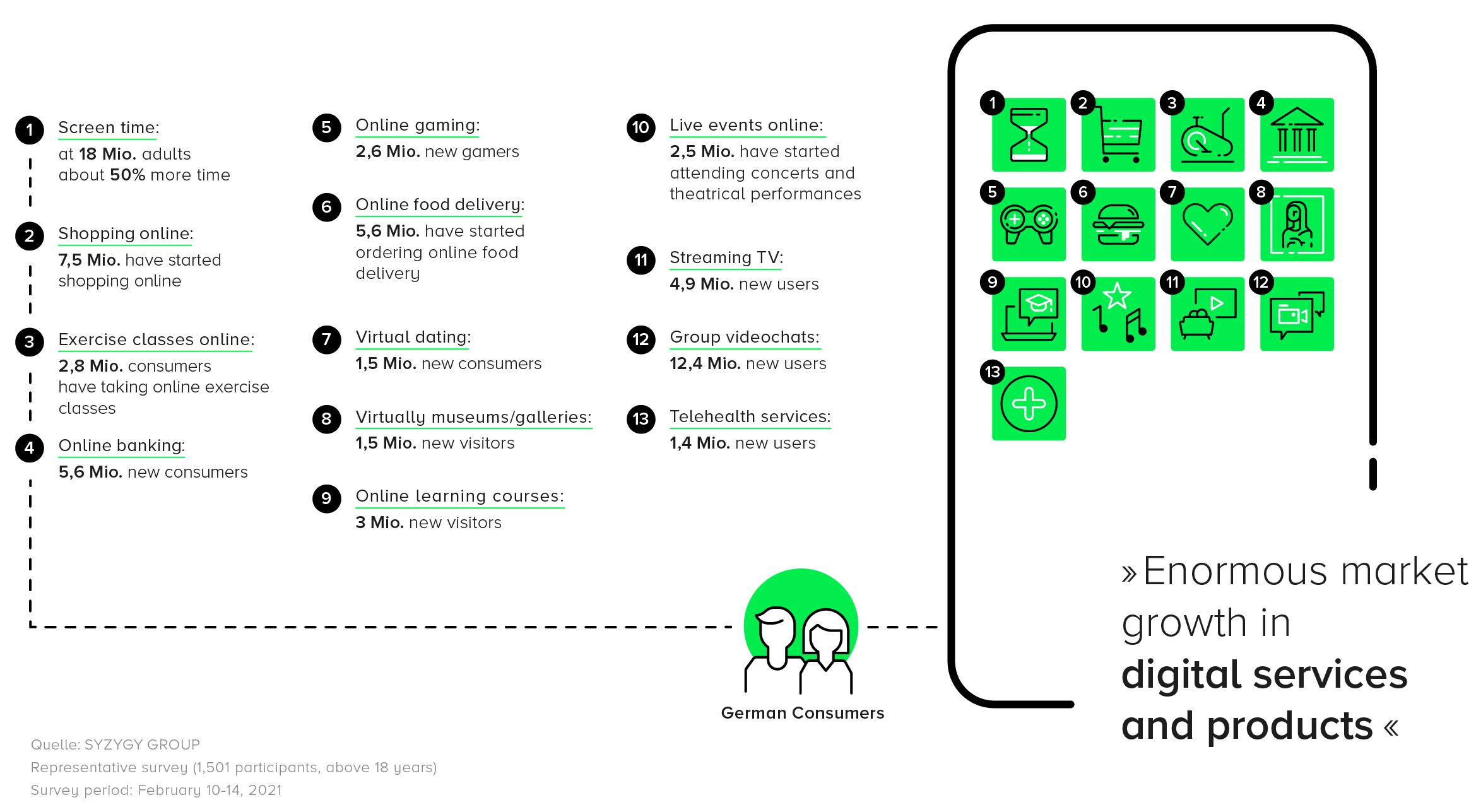The global coronavirus pandemic has triggered an unprecedented acceleration in the consumer uptake of digital products and services. Now consumer brands must step up to the challenge by accelerating their own digital transformation efforts.
from Dr Paul Marsden

Since the onset of the pandemic, 1.5 million adults in Germany have taken up virtual dating and have experienced their first screen-based romantic interlude with a significant other. Other Germans have lost their virtual virginity by seeking more platonic pleasures. During the pandemic a similar number have started using their digital screens for virtual visits to museums and galleries.
Overall, in the battle over screen time during the pandemic, screens appear to be winning. A recent digital insight survey by SYZYGY found, unsurprisingly, that the average daily screen time has increased for the majority of adult German consumers since the outbreak. But the size of the increase is impressive; 18 million Germans have seen their daily screen time jump by 50 percent or more. This three-country survey of 4,500 adult consumers found similar jumps in the UK and US.
But what’s most striking is the finding that the pandemic has prompted new consumers to cross the digital divide and embrace new aspects of a more screen-centric life. Since the outbreak, 2.8 million Germans have sweated to their first ever online exercise class, 3 million have followed their first online course, 5.8 million have made their first order with an online food delivery service, and 7.5 million German consumers have made their first e-commerce purchase. The pandemic has accelerated digital adoption at an unprecedented rate.

The other striking finding from the SYZYGY survey is the similarity between countries. Similar proportions of consumers have switched to digital solutions in Germany, the UK and the US during the pandemic. Indeed, the only notable difference appears to be a greater acceleration in the adoption of telemedicine in the UK and US compared to Germany. Whereas only one in fifty adults in Germany consulted a doctor virtually for the first time since the outbreak, one in six have did so in the US and UK. But overall, the pattern is the same. The pandemic has acted as a digital accelerant.
Overall, the pandemic has given rise what could be called the ‘Great Acceleration’ in the consumer adoption of digital products and services. In other words, right now the biggest digital transformation going on is the one happening in consumer lives. For many consumers, if something can be done on a digital screen, it is being done on a digital screen. This Great Acceleration will have major implications for consumer brands and businesses as we emerge from the pandemic.


Accelerating Digital Transformation
How consumer brands react to the Great Acceleration will depend on how they interpret what’s going on. One view is to look at accelerated uptake of digital products and services as an anomalous and temporary blip.
From such a perspective, our screen-centric pandemic lives can be seen as a short-term adaptation to viral fears and public health restrictions. Once constraints and anxieties dissipate, consumer behaviour will revert, more or less, to pre-pandemic patterns. People will ditch their screens and return in droves to physical stores, cinemas, airports, galleries, bank branches and gyms. Pre-pandemic normality will be restored. In this scenario, all consumer brands need to do is weather the pandemic storm and wait for business as usual to return.
Whilst such a view might be reassuring, there are at least two reasons why it is less than plausible. Firstly, what has happened during the Great Acceleration is simply an acceleration of a trend that was already underway in pre-pandemic times. In Germany, as in the UK, US and elsewhere, consumers were already shifting – albeit at a slower pace – to digital banking, shopping and media and towards more home-tech, health-tech, ed-tech and work-tech. COVID has simply acted as a digital accelerant, increasing the rate of change, rather than changing things per se. From this perspective, there is little reason to expect pre-pandemic trend towards ever more digitalisation to disappear or shift into reverse once we finally emerge from the pandemic.
![Dr. Paul Marsden]()
But in the future, there will be more options than ever before – with new standards for speed, simplicity and value
Another reason to be wary of a ‘back to pre-pandemic normality’ assumption is that the Great Acceleration has established new digital habits, expectations and norms that may be difficult to shake off. Specifically, the well-tested diffusion of innovations framework shows that new habits, expectations and norms that determine behaviour tend to ‘stick’ and spread if they are perceived as offering a relative advantage over non-digital alternatives.

Even if post-pandemic consumer behaviour does shift back towards pre-pandemic norms, the pandemic will have shifted norms and expectations. Specifically, consumers will judge options against digital standards for speed, ease and value. This means that many consumer brands will urgently need to upgrade their competitive value propositions in order to retain or regain their reach, relevance and relatability.
The alternative is to pray for a virulent wave of neo-Luddite nostalgia or technophobia to sweep through the post-pandemic world. If this happens, then digitalised consumer lives may ‘de-digitalise’ as people ditch digital norms and revert to yesteryear traditions
Betting on Digital Culture
As we emerge from the Great Acceleration, consumer brands and businesses have a clear choice to make. Look forward and embrace a more digitalised future or look back and hope for a return to a more analogue past.
For forward-looking businesses and brands, the future is exciting and full of opportunity. The pandemic has shown us a glimpse of a future where digital technology has shown it can create genuine value by helping people adapt to challenging times and situations. The big opportunity now is to seize this vision of digital as a value-creator, and work to cultivate a vibrant digital culture that tackles the big challenges facing businesses in a post-pandemic world.
How can digital technology increase value for customers, consumers and communities by meeting or beating their expectations? How can digital innovation be put to the service of supporting and protecting the environment? How can digital solutions better support employees in developing new skills for a rapidly changing world? How can digital ingenuity help businesses deal more fairly and ethically with suppliers and partners? And how can digital initiatives create long-term value for shareholders, who provide the capital for investment, growth and innovation. The answers to these questions are the building blocks of a next-generation digital culture that will help us build back better.
In summary, there is nothing positive about a pandemic that continues to destroy and upend human lives and livelihoods. Yet one of the consequences of the pandemic – the accelerated adoption of digital technologies – has the potential to be positively transformational. By nurturing a positive digital culture that understands the potential of digital technology to transform lives and unlock potential for good, we can build back better.
The future is bright, the future is digital.


